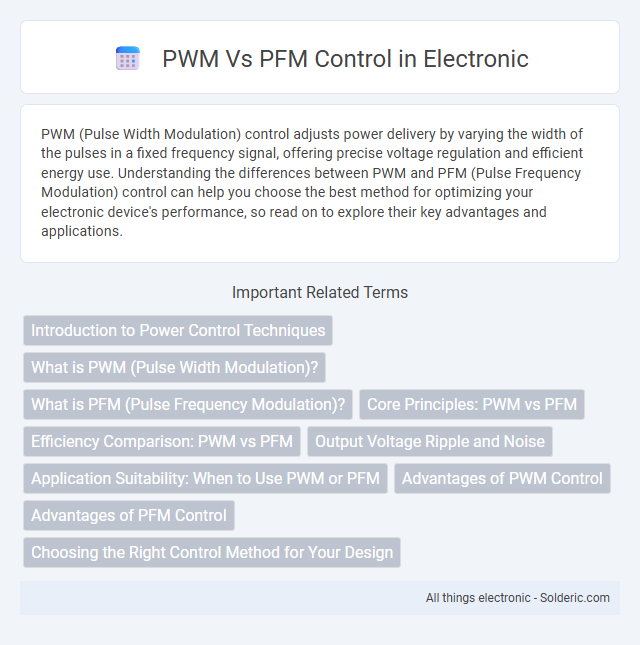PWM (Pulse Width Modulation) control adjusts power delivery by varying the width of the pulses in a fixed frequency signal, offering precise voltage regulation and efficient energy use. Understanding the differences between PWM and PFM (Pulse Frequency Modulation) control can help you choose the best method for optimizing your electronic device's performance, so read on to explore their key advantages and applications.
Comparison Table
| Feature | PWM (Pulse Width Modulation) | PFM (Pulse Frequency Modulation) |
|---|---|---|
| Control Method | Modulates pulse width at constant frequency | Modulates pulse frequency at constant pulse width |
| Efficiency | High efficiency at medium to high loads | High efficiency at light loads |
| Switching Frequency | Fixed frequency | Variable frequency |
| Output Ripple | Lower output voltage ripple | Higher output voltage ripple |
| EMI (Electromagnetic Interference) | Higher EMI due to fixed frequency switching | Lower EMI due to spread spectrum switching |
| Application | Power supplies, motor control, audio amplifiers | Battery-powered devices, low power regulators |
| Complexity | Moderate control complexity | Lower control complexity |
| Noise | Consistent noise profile | Variable noise due to frequency changes |
Introduction to Power Control Techniques
Pulse Width Modulation (PWM) and Pulse Frequency Modulation (PFM) are essential power control techniques used to regulate voltage and current in electronic devices. PWM varies the duty cycle of a fixed-frequency signal to control power delivery, optimizing efficiency and reducing electromagnetic interference in applications like DC-DC converters. PFM adjusts the switching frequency based on load demands, enhancing light-load efficiency and reducing power consumption in battery-operated systems.
What is PWM (Pulse Width Modulation)?
PWM (Pulse Width Modulation) is a technique used to regulate power delivery by varying the width of electrical pulses in a fixed frequency signal, effectively controlling the average voltage supplied to a device. This method is widely used in motor control, LED dimming, and power supply regulation to optimize efficiency and reduce heat generation. Your system benefits from precise control and energy efficiency when employing PWM for voltage or current modulation.
What is PFM (Pulse Frequency Modulation)?
Pulse Frequency Modulation (PFM) is a control technique where the switching frequency varies according to the load demand, maintaining a constant pulse width while modulating the frequency of pulses. PFM is often used in power converters to improve efficiency at light loads by reducing switching losses compared to Pulse Width Modulation (PWM). This method enhances battery life in portable devices by dynamically adjusting the output power without compromising voltage regulation.
Core Principles: PWM vs PFM
PWM (Pulse Width Modulation) control regulates output voltage by varying the duty cycle of a fixed-frequency signal, providing precise and stable power delivery ideal for applications requiring constant voltage. PFM (Pulse Frequency Modulation) control adjusts the switching frequency based on load demand, improving efficiency at light loads by reducing switching losses. Your choice between PWM and PFM depends on whether consistent output or power efficiency during varying loads is the priority.
Efficiency Comparison: PWM vs PFM
Pulse Width Modulation (PWM) control provides consistent switching frequency, resulting in stable output voltage and moderate efficiency across varying loads. Pulse Frequency Modulation (PFM) adjusts switching frequency based on load demand, significantly improving efficiency at light loads but potentially introducing more noise and ripple. Your choice between PWM and PFM impacts overall power efficiency, with PFM typically favored for low-power applications and PWM for steady performance under heavy loads.
Output Voltage Ripple and Noise
PWM control typically produces a higher frequency output voltage ripple with a consistent amplitude, which can be effectively filtered but may cause electromagnetic interference in sensitive circuits. PFM control lowers output voltage ripple amplitude by adjusting the pulse frequency to match load conditions, resulting in reduced noise and improved efficiency at light loads. Your choice between PWM and PFM will impact the noise profile and ripple characteristics, influencing overall system stability and electromagnetic compatibility.
Application Suitability: When to Use PWM or PFM
PWM control is ideal for applications requiring stable, low-noise output and consistent power delivery, such as motor control and LED dimming. PFM control excels in battery-powered devices where efficiency at light loads is critical, including portable electronics and power-saving modes. Choosing between PWM and PFM depends on balancing noise tolerance, load conditions, and energy efficiency needs.
Advantages of PWM Control
PWM control offers precise regulation of output voltage by maintaining a constant switching frequency, which enhances electromagnetic compatibility and reduces noise in power supply circuits. Its ability to provide consistent power delivery and high efficiency makes it ideal for applications requiring stable and smooth output, such as motor drives and LED dimming. Choosing PWM control ensures Your system benefits from improved thermal management and reliable performance under varying load conditions.
Advantages of PFM Control
PFM control offers higher efficiency at light loads by adjusting pulse frequency rather than duty cycle, reducing switching losses and electromagnetic interference. This control method extends battery life in portable devices and improves thermal performance by lowering heat generation. Your systems benefit from enhanced energy savings and quieter operation compared to traditional PWM control.
Choosing the Right Control Method for Your Design
PWM control offers precise and stable output voltage regulation, making it ideal for applications requiring consistent performance under varying loads. PFM control excels in efficiency at light loads by varying pulse frequency, which reduces switching losses and conserves battery life. Selecting between PWM and PFM depends on the design priorities such as power efficiency versus output stability and the operational load conditions.
PWM vs PFM control Infographic

 solderic.com
solderic.com